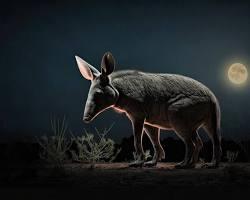The aardvark, a fascinating creature native to sub-Saharan Africa, is a one-of-a-kind mammal with a peculiar appearance and an interesting lifestyle. Its name, derived from Afrikaans and meaning "earth pig," aptly describes its burrowing habits and pig-like snout. However, despite its superficial resemblance to pigs, the aardvark is actually more closely related to elephants and hyraxes.
Physical Description
Aardvarks are medium-sized mammals, typically reaching lengths of up to 2.2 meters (7.2 feet) including their tails. They possess a stocky build with powerful legs and a distinctive elongated snout. This snout, which lacks fur and ends in a pig-like disc, is packed with sensory organs that help aardvarks locate their prey – ants and termites. Their long, sticky tongues, exceeding a meter in length, are perfectly adapted for snatching up these insects from their underground dwellings. Aardvarks also have excellent hearing and strong claws for digging.
Solitary and Nocturnal
Aardvarks are primarily solitary creatures, only coming together for mating purposes. They are strictly nocturnal, emerging from their burrows under the cover of darkness to forage for food. Their eyesight is poor, but their keen sense of smell and hearing compensate, allowing them to navigate their environment and locate termite mounds with remarkable precision.
A Diet of Ants and Termites
Aardvarks are insectivores, with their primary food source being ants and termites. Using their sharp claws, they efficiently tear open termite mounds, then utilize their long, sticky tongues to extract the insects with lightning speed. A single aardvark can consume tens of thousands of insects in a single night!
Burrowing Experts
Aardvarks are skilled burrowers, creating extensive underground tunnels that can stretch up to 6 meters (20 feet) in length. These burrows provide shelter from the sun and predators, and also serve as nesting sites for females to raise their young. Interestingly, aardvarks may not always reside in the same burrow each night. They often dig temporary shelters for sleeping, while maintaining a primary burrow for breeding.
A Remarkable African Specialist
With their specialized adaptations and fascinating lifestyle, aardvarks occupy a unique ecological niche in sub-Saharan Africa. Their role as insectivores helps to control termite and ant populations, maintaining a healthy balance within the ecosystem. Through continued conservation efforts, we can ensure that these remarkable creatures continue to thrive for generations to come.


